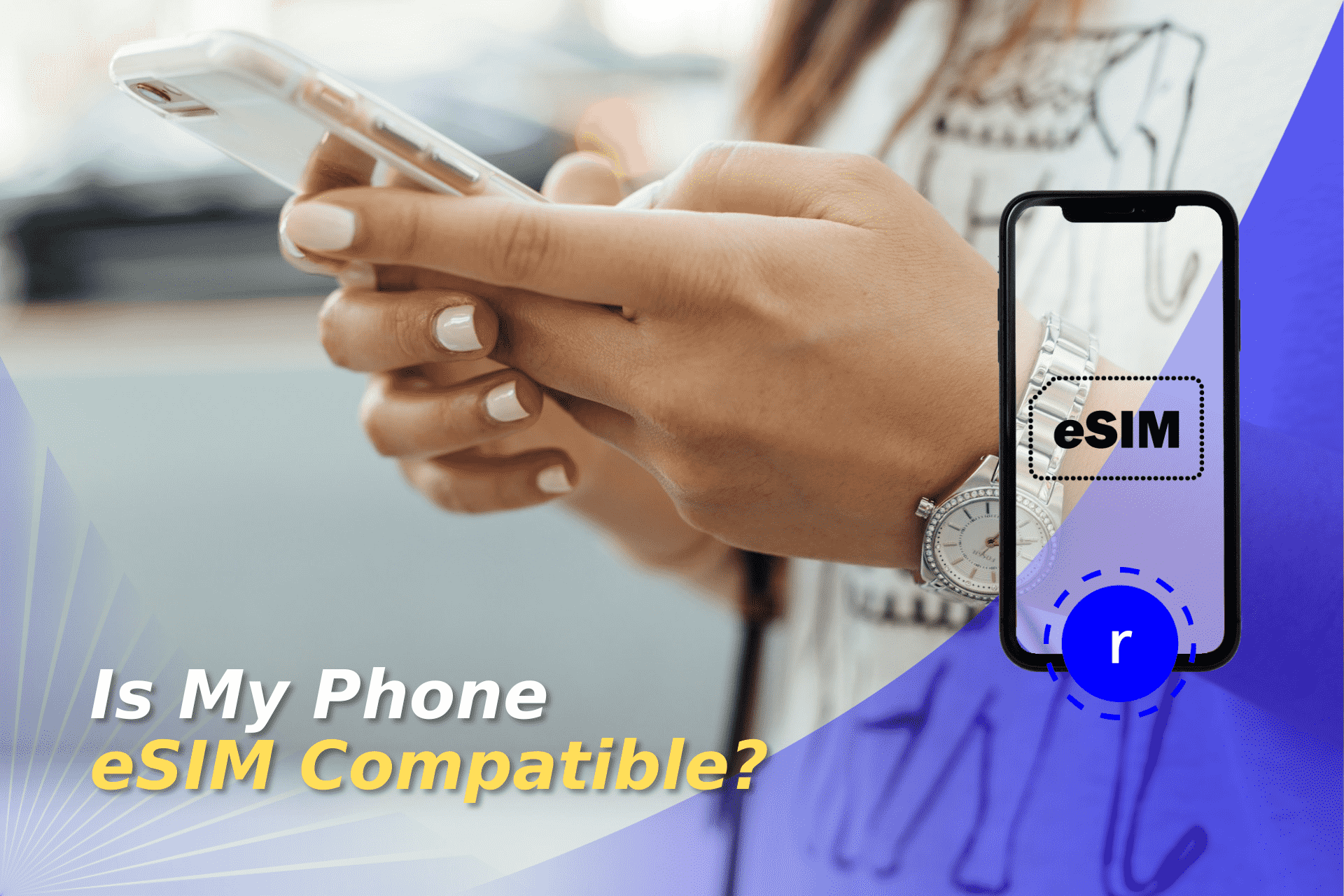Moving your eSIM to a new iPhone is a quick and simple process. Follow this step-by-step guide to en...
eSIM Cards
To check phone for eSIM, you just need to go into your phone’s settings, but the steps vary slightly depending on whether you’re an Android or an iPhone user.


Both Android and iPhone devices have built-in settings for checking eSIM compatibility. Additionally, most carriers provide online tools for checking your specific phone model. In this guide, we’ll cover how to check if your specific device supports eSIM and which models are generally eSIM-compatible.
While eSIMs are super convenient, not all networks or devices support it, and it’s important to check before you buy so that you don’t end up wasting your money. In fact, some devices are only eSIM-compatible depending on the region where you buy them, so there’s a lot to consider!
Here’s how to check if your device works with eSIM.
If you’re unsure whether your phone supports eSIM, there are several ways to check. Most modern smartphones have eSIM capabilities, but compatibility varies depending on the model, manufacturer, carrier, and even region.
One of the easiest ways to check compatibility is through online sources. You can simply Google eSIM-compatible phones and get a full list, or search for your specific device.
Find out below how to find out if a device from your manufacturer supports eSIMs.
Apple has been a major prominent of eSIM technology, integrating it into many of its recent iPhone models. Starting with the iPhone XS, XS Max, and XR, Apple introduced dual SIM functionality, allowing users to have both a physical SIM and an eSIM on the same device.
With the iPhone 14 series, Apple took a bold step by removing the physical SIM card slot entirely from US models, making eSIM the only option. Apple has since publicly embraced eSIM technology, stating that it simplifies connectivity and enhances security. While they haven’t explicitly announced when they’ll fully phase out physical SIMs worldwide, it’s likely that future iPhones will rely more on eSIMs.
If you’re unsure whether your iPhone is eSIM-compatible, follow these steps:
You can also contact your carrier to verify eSIM support and check that your phone is carrier-unlocked.
Android devices have gradually adopted eSIM technology, but support varies by brand and model. We’ll cover each manufacturer in more detail below, but you can also check this section for rough instructions.
Google Pixel was one of the first Android phone lines to introduce eSIM, starting with the Pixel 2. Samsung followed suit with select Galaxy models, and other manufacturers have also begun to incorporate eSIMs into their flagship devices.
Unlike Apple, which has made eSIM standard in all recent iPhones, Android manufacturers decide on a per-model basis. Some budget and mid-range devices may lack eSIM support, even if higher-end models from the same brand have it. Future Android devices are expected to include eSIMs more widely as network providers shift toward digital SIM technology.
You can check if your device supports eSIM by following these steps:
Samsung has integrated eSIM technology into many of its flagship smartphones, but not all models support it. The Galaxy S20 series was the first to introduce eSIM compatibility, followed by newer devices like the Galaxy S21, S22, and S23 series. The foldable Galaxy Z Flip and Z Fold models also support eSIM. However, some regional versions of Samsung devices–especially those sold in markets like the US and Canada–may lack eSIM functionality due to carrier restrictions.
For future models, Samsung has not officially announced plans to go fully eSIM-only. However, as more mobile carriers transition to eSIM, Samsung is expected to continue supporting this technology in its flagship and premium models.
Here’s how to check if your Samsung is eSIM-compatible:
Google was one of the first smartphone brands to adopt eSIM technology, starting with the Pixel 2 (but only for certain carriers). Since then, most Google Pixel devices have supported eSIM, including the Pixel 3, Pixel 4, Pixel 5, Pixel 6, Pixel 7, and the Pixel 8 series. If you own a Pixel device released after the 3, chances are high that it supports eSIM.
Google has not announced plans to remove the physical SIM slot entirely, but newer devices continue to support both eSIM and traditional SIM cards.
You can check if your Google Pixel supports eSIM by following these steps:
Xiaomi has gradually introduced eSIM support in select models, primarily in its high-end flagship series. Some of the latest Xiaomi devices that support eSIM include:
However, not all Xiaomi phones support eSIM, especially in global markets. Xiaomi tends to include eSIM functionality only in specific regions, such as China and some parts of Europe, while skipping it in others. If you own a Xiaomi device and are unsure about eSIM support, it’s best to check directly in your phone’s settings.
Here’s how to check if your Xiaomi supports eSIM:
Huawei has integrated eSIM support into some of its premium smartphones and smartwatches. But not all devices are eSIM-compatible, as availability depends on the model and region. Huawei tends to enable eSIM functionality in flagship models but may limit support in certain markets due to carrier restrictions.
Some Huawei smartphones with eSIM support include:
However, newer models like the Huawei P60 series have not widely advertised eSIM support.
Here’s how to check if your Huawei smartphone supports eSIM:
Apart from Apple, Samsung, Google, Huawei, and Xiaomi, several other brands have started integrating eSIM technology into their smartphones. While eSIM adoption is still growing, many flagship and premium models from various manufacturers now support it.
Here are some of the other brands offering eSIM support:
Since all these brands run on Android, you can check their eSIM support by following a similar process:
Since eSIM availability often varies by region and carrier, users should confirm with their mobile provider before relying on eSIM functionality in their device.
Using an eSIM is a simple process, but it involves a few key steps: buying, installing, activating, and connecting to a network. Here’s a general guide to get you started.
First, you need to buy the eSIM.
Then, you can install the eSIM.
After that, you can activate the eSIM.
Then, you can connect to the network. You may need to troubleshoot this.
Several major mobile carriers in the USA support eSIM technology, especially since new iPhones don’t have physical SIM cards. The three main carriers (Verizon, AT&T, and T-Mobile) all offer eSIM services, along with some smaller providers and MVNOs.
If you want to know whether your carrier supports eSIM, you can visit the carrier’s website and check the help or FAQ section. Alternatively, call or email customer support to find out more.
Yes, you can often use a SIM and an eSIM together, but it depends on your device and carrier. Many newer smartphones support dual SIM functionality, which means you can toggle between using your SIM card and an eSIM at the same time; this can be useful for separating work and personal numbers or managing international travel plans. However, there are some restrictions, so it’s important to check with your provider.
The number of eSIMs an Android device can store depends on the brand and model. A Samsung Galaxy S23 can store multiple eSIMs but only use one at a time, while the Google Pixel 8 supports dual active eSIMs. It’s important to check your specific device.
Apple devices have expanded eSIM capabilities over the years, with the iPhone 14 and 15 models in the USA supporting two active eSIMs at once. Globally, iPhones 13 and later can store multiple eSIMs, but only two can be active at once.
Yes, many eSIM-compatible phones support dual SIM dual standby (DSDS), allowing you to use both a physical SIM and an eSIM simultaneously. This means you can:
- Make calls and send texts from both numbers.
- Use mobile data from one SIM while keeping the other active for calls.
- Set a default SIM for different tasks.

